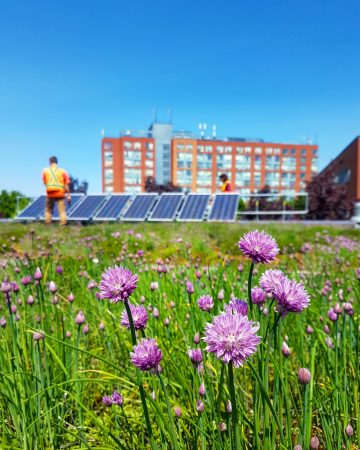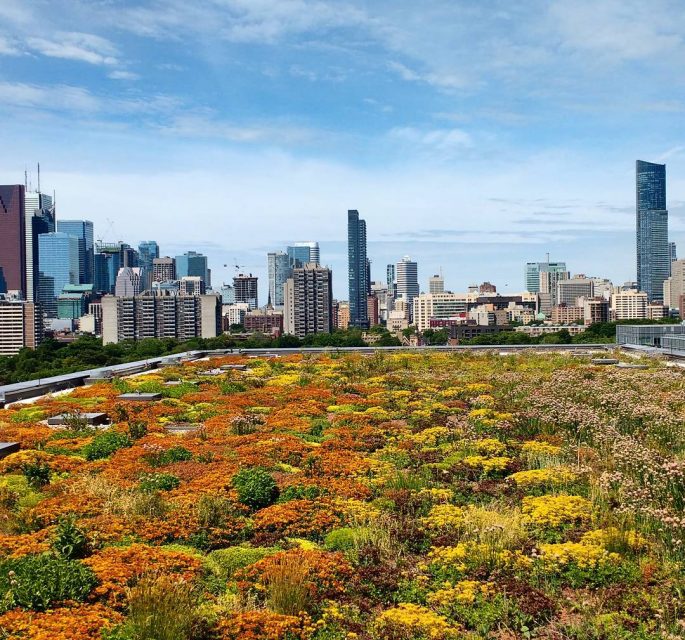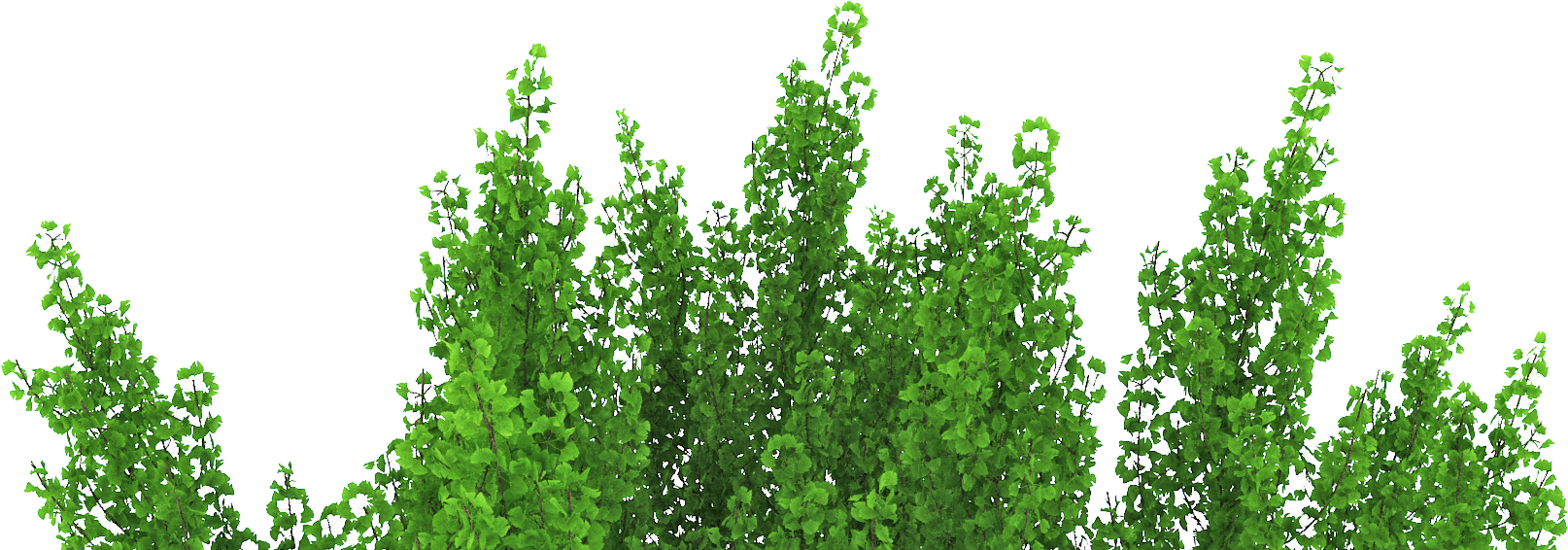Integrating Green Roof and Photovoltaic Systems
Integrating green roof Photovoltaic (PV) panels systems has traditionally been seen as two distinct technologies vying for roof space.
“Time and time again, researchers have observed a positive correlation between PV module efficiency and green roof health.”

According to the City of Toronto’s Green Roof Bylaw, new buildings subject to the policy may deduct roof area dedicated to renewable devices from their total required green roof area. This often results in two spatially distinct roof areas, one with PV panels and the other with vegetation. In fact, GINKGO’s experience pairing these two systems supports scientific evidence from around the world that integrating green roofs and PV panels may result in mutually reinforcing benefits. Recognizing the synergistic benefits of pairing green roof technology with PV panels is important for architects and engineers designing buildings within the urban core, especially across North America, where 30% of emissions can be attributed to building operation and construction[1].
Now more than ever, governments are taking action to reduce their greenhouse gas (GHG) emissions. Toronto has committed to city-wide emission reduction targets of 80% from 1990 levels by 2050. Federally, in October 2018, the Liberal government announced a carbon tax on fuel producers and large emitters. They did this to achieve national targets of 30% emission reduction from 2005 levels by 2030. Incorporating low emission clean technology into city design is integral to achieving these targets and reducing dependency on conventional fuels.
The Benefits
Further, green roofs have measurable benefits on environmental concerns, such as stormwater runoff and the Urban Heat Island (UHI) effect. All of which can be further enhanced when paired with PV technology. As the topic of study by academics and industry alike, researchers have observed a positive correlation between PV module efficiency and green roof health.
One significant factor in this is the role green roofs play in rooftop temperature moderation. Higher temperatures negatively affect how efficiently PV panels can generate power. Based on Standard Test Conditions of PV panels operating at 25°C, a 1°C increase in ambient temperature causes a 0.5% reduction in the output of electricity[2]. Inefficiencies in PV panel output have economic and social implications. Building owners must purchase electricity to meet their energy needs, extending the payoff period of their PV investments and increasing demand on the electricity grid during peak hours.
Green roofs can mitigate losses
Green roofs can mitigate losses to PV panel output by lowering the ambient temperature of the green roof area. A recent study by green roof manufacturer ZinCo found that integrating a solar base with their green roof system improved PV panel efficiency by 5%. This is compared to a white PVC (white roof) with solar panels. In Toronto, 2018, research from the Green Roof Innovation Testing Laboratory (GRIT Lab) found that Green Roof PV systems resulted in lower surface temperatures (greater cooling) than White Roof PV systems. The study also reinforced the negative effect of temperature on PV panel performance. As well as the positive influence of green roof systems on PV power output.[3]
Another study, from Spain in 2013, found that pairing PV systems with a sedum green roof resulted in lower rooftop surface temperatures. As well as an average increase of 3.33% in electricity output compared to the conventional gravel roof.[4] These results are supported by research in Germany, China, New York, and Portland.
In addition to moderating roof temperatures to improve PV efficiency, green roofs also contribute to energy savings for the building. Research specific to the Toronto region calculates energy savings resulting from green roof installation as equal to 6.52 kWh/m2/year.[5] By pairing photovoltaics with living components that lower ambient air temperature, building owners can achieve higher outputs from PV efficiencies and reduce energy demand within the building. Thus, integrated systems generate savings in a variety of ways.
The benefits of green roofs for PV panel power generation are not one-sided.
In fact, studies have shown that PV panels enhance the performance of the plant community they are installed above. A study in Denver, Colorado, found that plants in the shade of PV panels had higher growth rates with a greater spread. As well as an overwinter survival rate 35% higher compared to plants in exposed areas.[6]
Additionally, shaded areas create microclimates atop the green roof and allow a more diverse range of plants and insects to establish, contributing to expanded rooftop biodiversity[7]. In studies, introducing specifically paired plant types leads to green roof ecosystem services improvements. Things such as temperature moderation, reflectivity, and evapotranspiration rates.[8] One consideration for the long-term success of pairing PV panels with green roofs is regular maintenance to ensure that vegetative growth, specifically taller herbaceous plant species that may be present on a prairie meadow green roof are trimmed regularly to minimize shading on PV panels.
Ginkgo Sustainability has installed and maintained integrated green roof and PV systems.
Moreover, we work with suppliers who have expertise in the technical aspects of these systems. For example, ZinCo Canada offers a green roof and integrated solar system that uses the green roof components to fasten solar panels, avoiding penetration of the waterproofing membrane[9]. Ginkgo Sustainability currently maintains a green roof using this system on a long-term care home in Peel Region.
However, contrary to popular belief, green roofs and photovoltaic panels are mutually beneficial technologies. They enhance each other’s benefits when paired in the same roof space. As a result, these benefits have been recognized by San Francisco. The Better Roof Ordinance of 2017 requires green roofs, solar panels, and integrated systems on almost all new construction. [1] Yet, with looming environmental pressures and UN reports that irreversible effects of climate change are only 12 years away[2], it is crucial that low-impact clean technology be integrated into our built environment to maximize economic and environmental returns.
References
[1] Canada Green Building Council. 2018.
[2] Future Oriented and Sustainable Green Roofs in Germany. Greening Rooftops. 2012.
Numerical analysis on the thermal characteristics of photovoltaic module with ambient temperature variation. Solar Energy Materials and Solar Cells. 2011.
[3] https://tspace.library.utoronto.ca/bitstream/1807/89540/3/El_Helow_Dalia_201806_MAS_thesis.pdf
[4] Photovoltaic-green roofs: An experimental evaluation of system performance. Applied Energy. 2014.
[5] Report on Environmental Benefits and Costs of Green Roof Technology in the City of Toronto. Ryerson University. 2005.
[6] https://www.researchgate.net/publication/267293773_A_photovoltaic_array_on_a_green_roof _in_Denver_Colorado_improves_resilience_of_green_roof_plants_by_expanding_habitat_heterogeneit
[7] Photovoltaic-Panels on Greened Roofs. 2012.
[8] Lundholm et al. Plant Species and Functional Group Combinations Affect Green Roof Ecosystem Functions. 2010.
[9] https://www.zinco.ca/green-roof-systems/green-roof-and-solar
[10] https://sf-planning.org/san-francisco-better-roofs#analysis





